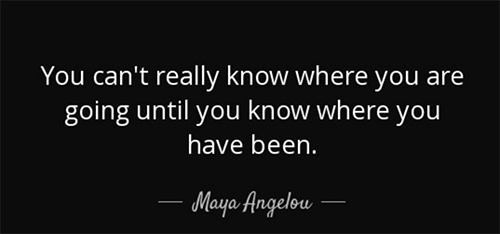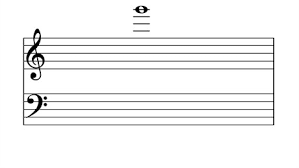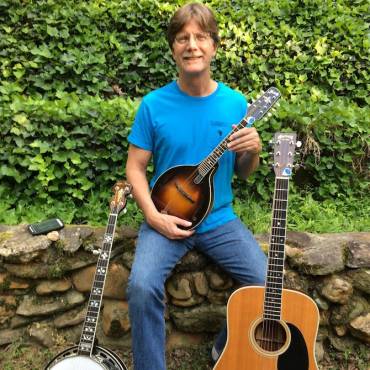The Best 10 Ways to Expand Your Vocal Range Today!
One of the biggest reasons singers take voice lessons is to learn how to expand vocal range.
People have done lots of research on singers like Axl Rose and Mariah Carey and have found that they have a tremendous range.
(Which singer has the most octaves? That award would seem to go to Axl Rose with an impressive 5 singing octaves [I am excluding vocal fry and whistle tones]. You can check out this awesome vocal range chart for the comparison.)
A ton of students come to me asking how to get more octaves in your voice.
But vocal range isn’t just about getting those high notes although many singers want to know how to expand vocal range higher.
Other vocalists want to learn how to sing low notes as well.
Whichever camp you fall into, here’s the bottom line:
Understanding your vocal range is an incredibly important first step in understanding your voice.
Can you expand vocal range?
Here are a few common questions I hear from singers who are just starting out:
“Can my vocal range increase? Or is it set in stone? Is it even possible to widen your vocal range?“
“If so, does singing in falsetto increase range on the high end?”
“I’m wondering how to expand my vocal range lower. Is there a limit to my vocal range at either the low or high end?”
These are all great questions.
Here’s the answer:
Almost any singer can expand their range!
It just takes some singing exercises to expand vocal range.
So today, let’s talk about your vocal range, and along the way I’ll show you some great exercises to expand your vocal range.
By the way, if you want a vocal program that will take you through these singing techniques and a ton more, you can check out my complete singing course, Master Your Voice, here.
Here’s a quick preview of all the ways that singers can expand their range:
What is My Vocal Range?
The first step in understanding how to expand vocal range is knowing what your current range is.
After all:

So here’s how to find your range.
- Go to your piano or download a free digital piano app–I like the app “Real Piano”. It works for Android and Mac.
- Find Middle C (labeled C4 on Real Piano) and sing the note on an “Ah” vowel.
- Once you’ve found the note, sing “Ah” on each note downward from Middle C until you hit your lowest note.
*A good rule of thumb is that a man will probably be able to sing down to a C3 or below and a woman will be able to sing down to an A3 or below. - Mark the lowest note you can sing.
- Next, find Middle C again and repeat the process except moving up from Middle C to as high as you can sing on an “Ah” vowel.
- Mark the highest note you can sing.
Also, if you’d like a free vocal range test, I’ve developed an app to test your range in only 6 seconds!
This will help you determine which voice type you are.
I’ve written another article on the different voice types.
So take a look at it so you know what to expect from your voice.

But to sum of the contents of the article, just understand that most singers are some kind of tenor (for males) OR some kind of soprano (for females).
That’s not to say that basses and altos don’t exist.
Just that those vocal ranges for males and females are rare.
And we shouldn’t let these labels dictate how high we think we can sing.
The fact is that most singers between the ages of 20 and 60 can expand their vocal range.
While we may not increase everyone’s range by octaves, there’s usually a noticeable improvement.
How Does Vocal Range Work?
How much can you expand vocal range? Can you extend your vocal range lower or higher with the right exercises?
Well, to answer these questions, we first need to look at how vocal range works.
You may have a lower or higher voice than others, but some of the principles of range are true for everyone.
The vocal mechanism expands vocal range by thinning and lengthening the vocal folds.

This is similar to the strings on your guitar.

As the size of the string gets smaller, the speed of the vibrations increase.
This increases the vibrations per second (also known as hertz) which results in a higher pitch.
The opposite is also true.
The thicker the guitar string, the slower the vibrations and the lower pitch you hear.
Your voice works in the same way. In the larynx (or voice box), the vocal folds stretch and thin.
This makes them vibrate faster and the pitch increases.
The vocal cords can also shorten and thicken which would create a lower pitch.
How Much Can You Increase Your Vocal Range?
All this talk about stretching vocal folds and hertz can make vocal range really confusing.
But what if you just want to know how far can you expand your vocal range?
Well in my experience, I can tell you that many singers can expand their range by one octave or more.
How does this happen?
Well, there are many singers out there that have never actually sung in their higher registers (such as head voice) before.
If that sounds like you, it will be easy to learn how to increase your vocal range by an octave because you were literally missing a large section of your range before.
For other more developed singers, we can work on lots of great exercises to expand vocal range but it may take a while to get an extra perfect 5th (or 7 musical notes) in their voice.
How long does it take to increase vocal range?
Well, depending on the singer, it could happen in as little as 30 minutes or as much as a year or more.
How long to expand vocal range? It really completely depends on the level of the singer.
Perhaps an even better question is “what is considered a large vocal range?”
It can be very easy to get into a “range measuring” contest when you hear about singers with 5 octaves of range.
I know the feeling! Every time I hear Axl Rose’s vocal fireworks on Sweet Child O’ Mine, I can’t help but think: “How can I expand my vocal range to match his?”
But relax!
For a trained singer, 2 and a half octaves is a fantastic range!
And truthfully, there’s a lot you can sing with only 2 octaves.
How to Increase Vocal Range without Falsetto
With vocal range extension, the trick is to allow the cords to stretch in a safe and gradual way so they don’t thin too quickly.
If the vocal cords thin too fast, they lose the ability to resist airflow and you may flip or disconnect to falsetto.
I’ve also written an article discussing falsetto with several listening examples.

This is the flutey, breathy sound we hear when someone has not built up their ability to hit high notes without too much airflow.
How to Improve Voice Range
The best way to increase voice range is by working with exercises that allow the vocal folds to stretch while still maintaining their ability to resist the air.
The vocal folds resist air like a door that opens and closes.
If the door is made of paper, I can very easily run right through it.
This is what happens when the vocal folds are too thin.
The cords can’t resist the air from the lungs and the result is a breathy falsetto.
However, if the doors are made of a sturdy material like wood, I will encounter resistance when I hit the door.
So in order to achieve a strong sound at the top of my voice, I must have resistance at the vocal folds so that I’m not just singing air on the top.
It’s very important that we have both stretch and resistance at the vocal folds in order to increase our range.
Just one won’t do it.
You need both.
A lot of students ask me about songs to expand vocal range. While singing songs is definitely the goal here, skipping straight to Bohemian Rhapsody or Bridge Over Troubled Water (two of my favorite songs with wide ranges) is like trying to run before you can crawl!
Whether you want to expand vocal range upwards or downwards (or both), starting with the right exercises is key.
So here are 10 vocal range exercises to help you hit higher notes without the breathy falsetto sound.
Don’t worry if you’re looking how to expand vocal range as a baritone or increase your vocal range as a male higher…
Based on all my years of teaching, I can say that these are the best, time-tested vocal exercises for singers to increase range.
10 Exercises to Expand Vocal Range
1. Sing with a tall posture
It may sound overly simple, but singing with the correct posture is one of the easiest ways to expand your vocal range.
In the case of singing, standing with a tall posture is the correct way to stand and hold your body for singing.
The tall posture is really quite simple to achieve.
There are basically four steps:
1. Bring your feet to about shoulder-width apart.

2. You should feel that your feet hips and shoulders are all in a line.
3. Stand up straight and gently lift your chest.

4. Make sure that you’re not slouching too far forward or too far backward but instead of form a straight line down your back.
2. Breathe from the diaphragm
Similar to singing with the correct posture, breathing from the diaphragm is one of the easiest ways to expand your vocal range.
Simply put, without the correct breath for singing, you will be able to sing with enough breath pressure to achieve high notes.
Luckily, the correct breath for singing is also quite easy to achieve. It basically breaks down into three steps:
1. Inhale through your mouth silently and allow the air to expand your stomach.

2. Make sure that as you’re inhaling there’s no movement in your shoulders or chest. The only movement should be your stomach expanding on the inhale.
Want to Nail Those High Notes?
Every singer wants to expand their range. Expand Your Range Fast will show you how to finally hit high notes in your voice without straining. Expand your range by 5 notes or more!
3. Finally as you exhale, you’ll feel that your stomach contracts.

This will be exactly the same as when you sang. You’ll inhale your stomach will expand, then as you saying, you’ll notice that your stomach naturally contracts.
3. Relax your jaw as you sing higher
Relaxing your jaw is a very easy way to reduce tension in your singing so that you can achieve higher notes.
Naturally as we start to sing higher in our voices, we will have to drop our jaw in order to match pitch with higher notes.

You can try this for yourself.
Simply try singing in an “ooh” vowel, as in the word oops from a low note all the way up to a very high notes. Try this in a mirror.
If you’re like 99% of people, you’ll see that as you ascend towards a higher note your jaw will naturally relax as you try to go up to the top notes.
Similarly, when you’re singing on an exercise or even a high note in a song, it will often be necessary to drop your jaw as you sing up the higher notes.
4. Feel for any tongue tension
One of my favorite ways for relaxing into your high notes is to feel for and eliminate any tongue tension.
Tongue tension will also typically cause the larynx to rise higher. As the larynx goes up, the vocal folds will tighten and often results in a vocal break.
Instead, you want to keep the tongue and larynx relaxed as you sing higher.
To feel for any tongue tension simply place your thumb underneath your chin and on the muscular tissue directly below your tongue.

As you feel this area with your thumb, swallow and you’ll feel the muscles beneath your tongue tighten.
As they’re singing, you want to make sure that this area of your throat stay as relaxed.
5. Try vocal sirens
Before we get into any crazy vocal exercises, it pays sometimes to try some very simple vocal expressions.
Don’t worry, there’s no keyboard or music knowledge required yet!
One of the simplest vocal exercises you can do to expand your range is a vocal siren.
In this case, you can try singing the vowels “ooh” or “ee” from a very low note all the way up to a very high note and back down.
This creates the siren sound that you might find on an emergency vehicle.
The trick with vocal sirens is to allow your voice to achieve the higher notes without getting tight or straining.
If you disconnect to a breathy falsetto, allow your voice to do that. But at all costs, try to avoid your voice from straining and tensing as you sing higher.
6. The 1.5 Octave Lip Trill
Ah, the lip trill. There has never been a more powerful, yet safe exercise to help you expand vocal range.
Let your lips flop together while you sing the vowel “uh”.
With the lip trill the vocal folds are in a close, safe environment.
This decreases the threshold force needed to get the vocal folds to vibrate.
The lip trill is the vocal equivalent of lifting weights in outer space.
By reducing the force necessary to do work, the vocal folds can resist the air coming from the lungs much more easily.
The lip trill also promotes resistance and stretching of the vocal folds. This way, you can sing to the very top of your range without disconnecting to falsetto.
Here’s how you do it:
1. Blow out some air to make your lips flop together.
Just relax, and gently blow some air to make the lips gently vibrate together.
2. While your lips are flopping together, say the vowel “Uh” (as in “Utter”). It should have a bubbly sound like you’re under water.
3. Now find a comfortable starting pitch (try C3 for guys and G3 for girls) and allow the lips to flop together while you sing the “Uh” vowel.
4. Sing the following scale.
Here’s the scale for guys.

Here’s the scale for girls.

But if you can’t read music, don’t worry.
Here’s a video demonstrating the Lip Trill exercise with male and females keys.
7. The 1.5 Octave “ng”
The octave and a half exercise is one of the best exercises for singing from the bottom to the top part of your voice without any tongue tension.
This is a fantastic exercise an opportunity for you to feel underneath your chin for any muscular tension in your tongue.
Simply try to say the word “rung”, as in “he rung the doorbell”.
Can humming increase your vocal range?
Yes it can! And in this exercise, you’re basically doing an open-mouth hum.
Once you have found this “ng” consonant, try to hold this nasal sound.
Finally, sing the on a 1.5 octave scale like this:

8. The 1.5 Octave “Gee”
Let’s open things up a bit.
Open your mouth and sing the bright, forward “Gee” (as in “Geese”).
By opening your mouth to sing, we lose the advantage of the lower threshold we got from the lip trill.
But we’ve got two things going for us.
1) The “ee” vowel promotes stretch in the vocal folds, and…
2) The “G” consonant brings the vocal folds together.
Just try saying “Guh Guh Guh” and you’ll see what I mean.
The feeling you get when singing that glottal “G” consonant is the sensation of the vocal folds closing.
This combo of the “G” consonant with the “ee” vowel will allow you to hit some very high notes in your voice without disconnecting to falsetto.
Here’s how you do it:
- Begin by saying the word “Gee” as in “Geese” at a comfortable volume.
- While saying the word “Gee”, make sure that you are enunciating the “G” consonant.
- Now find a comfortable starting pitch (try C3 for guys and G3 for girls) and begin to sing the word “Gee”.
- Sing the following scale.
Here’s the scale for men:

Here’s the scale for women:

If you don’t know how to read music, no worries.
Here’s a quick video demonstrating the “Gee” exercise.
9. The Octave Repeat Bratty “Nay”
This is possibly the most famous Speech Level Singing and Institute for Vocal Advancement exercise for expanding range.
Probably because it’s one of the most silly.
Pretend you’re a little brat on the playground and sing a bratty, teasing “Nay”.
This is even wider than the “Gee” we just did, thus increasing the chances we might flip as we sing higher.
However, the bright, bratty sound we’re using will help thin the vocal folds while keeping them together.
With this exercise, the “ay” vowel is narrow enough to discourage flipping in the passage.
And the “N” consonant is excellent at resisting the air from your lungs.
Here’s how it’s done:
1. Begin by saying the word “Nay” (as in “Neighbor”) in a bratty way.
The tone should be buzzy and nasal-sounding.
We’re actually looking for that bright, brassy, “witchy” tone
2. Now find a comfortable starting pitch (try E3 for guys and C#4 for girls) and begin to sing the bratty “Nay” on this pitch.
3. Sing the following scale.
Here’s the scale for men:

Here’s the scale for women:

To get the most benefit out of this exercise, it’s important you do it right.
Watch this video to give you the right idea:
10. The 1.5 Octave “Mum”
To round out our vocal range extension exercises, I’d like to end with one of my absolute favorite exercises for expanding range.
It’s called the 1.5 octave “Mum”, as in the word mother.
Where the other exercises up until this point have favored a slightly more closed vowel sound, such as “ee” and “ay”, in this exercise we’re going to allow the vowel to relax a little bit more towards a more neutral, “uh” sound as in “other”.
Simply say the word “Mum”, as in “mother”, and sing it on the 1.5 octave scale like this:

A Few Things to Note
I truly hope these vocal range expansion exercises will be helpful to you in your own singing journey!
Can we increase vocal range? The answer, as you can see, is a resounding yes. Like all things in music, the answer is practice, practice, practice!
As a final note, keep in mind that all of these exercises are temporary steps to get you singing higher notes in your range.
While it would be amazing if you could expand your range upwards by an octave with just these exercises, the end goal is to sing well on songs.
Also, please don’t read this and think that all you have to do is make a bratty sound or blow your lips together and all your notes will sound beautiful.
They won’t.
These exercises simply allow the vocal folds to stretch while resisting the air from your lungs.
If you train your body to achieve this difficult task, it will be much easier to sing that way in a song.
If you’d like to learn to sing high notes in a song without falsetto, consider booking your first voice lesson at Ramsey Voice Studio to get started.
How Can I Put This to Use With My Own Voice?
If you’re still wondering how to expand your vocal range higher or lower, I created a free bonus video series that you can use to apply the most important info from this post in your own singing.
The bonus videos contain 3 bonus exercises to help you expand your vocal range.
Click the big download image for the free video below!

Want to Nail Those High Notes?
Every singer wants to expand their range. Expand Your Range Fast will show you how to finally hit high notes in your voice without straining. Expand your range by 5 notes or more!





10 Comments
Weird, everything is in upper case, all shouty-like. 🙂 I don’t think it’s me. Anything, can you be more specific with the app name? There are lots of them calling themselves real piano. Oh, and another wonderful article. It is just wonderful how much value you share for free.
Hey David, thanks for the message. Here’s the Real Piano app I mentioned: https://apps.apple.com/us/app/real-piano-lite/id400679199
Unfortunately the ALL CAPS is a part of the theme for the site. Don’t think I can change it…
Hi Matt.
I enjoyed you free video and I like how you show the scale exercises in music notes. I can’t play piano but can play guitar and read music and practice using my guitar.
That’s awesome Elaine! TBH, it’s not mandatory to be able to play the scales when you’re learning. But rather, you just want to be able to sing them as well as possible and you’ll make great strides!
Thanks a lot for this article and lesson
You’re so welcome Kyle!
Thank you so much sir matt!!!
You’re welcome!
LOVE THESE ARTICLES! I PRACTICE TO YOUR VIDEOS A LOT. KEEP THE GOOD WORK UP MR.RAMSEY, LOOKING FORWARD TO YOUR 23 JAN EVENT!
Thanks Shivam!
Add Comment